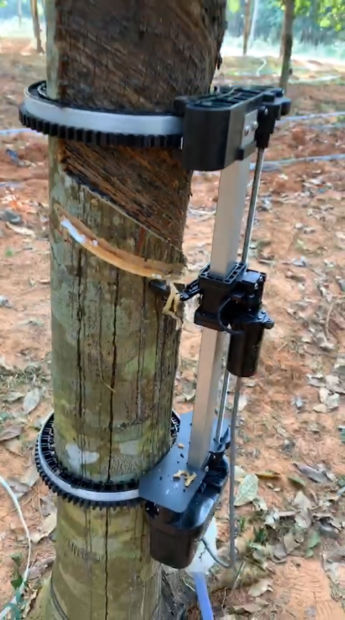STM LoRa chip automates rubber extraction
- September 22, 2021
- Steve Rogerson

Chinese company Cihevea is using LoRa technology from ST Microelectronics to automate extracting latex from rubber trees.
The application developed by the automated rubber-tapping specialist uses the Swiss electronic company’s 32WLE5 LoRa system-on-chip (SoC) and low-power networking to automate the rubber extraction process. Cihevea has equipped more than 200,000 rubber trees within its Hainan rubber-tree plantation with the device to improve rubber-tapping productivity and output capacity.
The SoC acts as an efficient, low-power communication hub and control centre for Cihevea’s rubber tapping robot that includes two precision motors and environmental sensors that monitor weather conditions, including temperature, air pressure and humidity.
Clamped to the tree, the SoC transmits the sensors’ data to a mesh gateway via a dedicated LoRa application network server, where the server can monitor, test, debug and coordinate the robots in the field. Once all pre-set conditions are met, the SoC triggers the rubber tapping motors to perform autonomous cutting, which usually happens very early in the morning.
This increases latex yield by two to three times while reducing damage to trees, prolonging the trees’ productive lifespan. In addition to improving yields and extending asset lifetimes, the rubber-tapping robot also resolves chronic labour shortages, as tree tapping can be difficult and dangerous for human workers.
“The fully-automatic, intelligent, rubber-tapping system is a revolution for the rubber industry,” said XU Zhen Kun, vice chairman of Cihevea. “With the increased use of platform technology and the ability to communicate via the low-power LoRa network technology provided by the STM 32WLE5, the smart rubber-plantation platform system is creating a new rubber-plantation ecosystem, moving away from traditional high-intensity, heavy-pollution, inefficient, production methods and is ushering in a new era of green environmental-protection, high-efficiency, digital transformation.”
The multi-modulation wireless SoC microcontroller combines an Arm Cortex‐M4 core running at 48MHz, a sub-GHz radio allowing long range connectivity, and a collection of STM-designed peripherals. It operates from a 5 by 5mm package and is an open platform supporting LoRa, (G)FSK, (G)MSK and BPSK modulations.
“While rubber trees are a sustainable source of an important material widely used in industrial, transport and agriculture sectors, improving rubber-tapping efficiency and increasing latex yield has long been a goal of rubber producers and using the STM 32WL5 and its LoRa networking is a natural fit,” said Arnaud Julienne, vice president for STM in Asia Pacific. “Moreover, our unique and broad portfolio of products in connectivity, sensing, and large portfolio of power-management and motor-control is well suited to the full range of smart farming domains, including tracking, irrigation systems, tractors and livestock position and health monitoring.”




